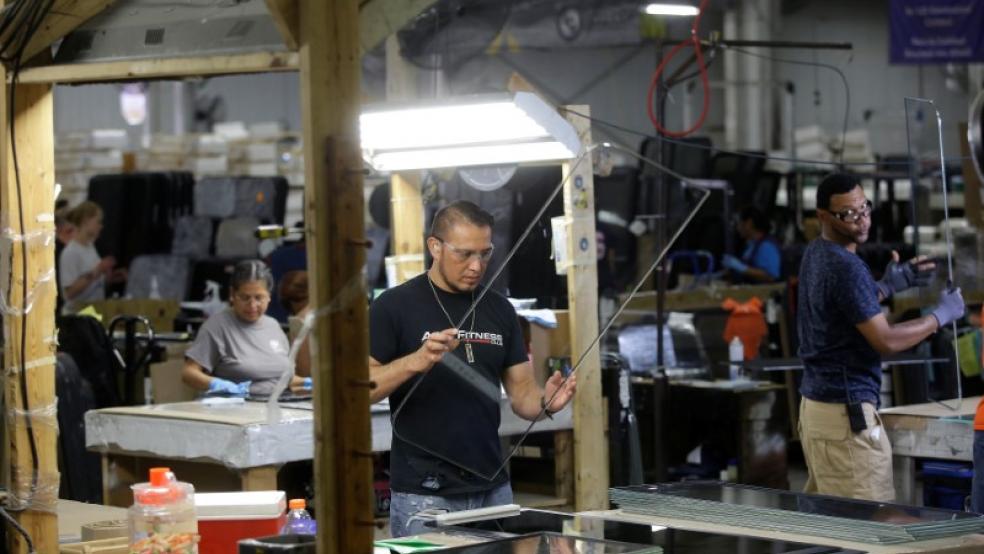Wage growth has been the missing link throughout a period that has produced more than 18.5 million new jobs, including 209,000 in July.
But Amy Glaser, who helps run Adecco Staffing, believes the befuddled policymakers, politicians and economists — not to mention the workers themselves — looking for pay to surge won't have to wait much longer.
Related: The Real Reason Stocks Are Hitting Record Highs
As she interacts with clients hungry to hire new employees, Glaser said she sees a climate where companies are going to have no choice but to start jacking up compensation in order to meet a changing climate. Adecco is the largest staffing firm in the world and specializes in connecting employers with workers.
"The demand for labor in this market is intensely high," she said. "In every discussion I'm having with my clients, wages are the No. 1 topic. I expect a substantial uptick in the average hourly earnings potential."
So far, substantial moves in the metric Glaser mentioned have been elusive.
In the most recent report on nonfarm payrolls growth, issued Friday, the Bureau of Labor Statistics said average hourly earnings rose 9 cents an hour, good for a 0.3 percent monthly gain that translates into a 2.53 percent annualized increase.
That's not exactly poor, and indeed is more than 1 percentage point higher than the current inflation rate. However, it has been running below a level that makes policymakers, like those at the Federal Reserve, comfortable. The Fed is the process of gradually raising interest rates, but is looking for stronger signs of "good" inflation to bolster the case for policy normalization after years of cheap money used to stimulate the economy.
Wall Street also believes wage growth is on the horizon, though there's little expectation of it being particularly dramatic.
Related: Most of US Love American-Made Goods, but Paying More for Them Is a Problem
"The fact that the unemployment rate continues to slide without acceleration in wages remains a puzzle," Bank of America Merrill Lynch economists said in a note Friday. "This could reflect a variety of factors including low productivity growth, employee insecurity about the health of the labor market, skill mismatch and sector specific stories. These factors likely will continue to be in play, but we think that it is only a matter of time before there is a modest move higher in wage growth."
But Glaser sees a number of dynamics at play in the labor market that she thinks might have a more pronounced impact on wages.
For one, she sees major demand for qualified workers. That's causing what Glaser described as the "need for speed" in hiring employees quickly after they interview.
"If someone applies for a job and you don't get to them within the first 12 hours, they're moving on to the next employer," she said.
Indeed, 34 percent of U.S. companies cite "talent scarcity" as their biggest issue, according to Randstad Sourceright. "While automation may continue to grow in the workplace, so too does the scarcity of talent, which is driving new approaches and big investments to fill jobs," Randstad CEO Rebecca Henderson said in a statement.
In that kind of environment, employers need to find more creative — and more expensive — ways to retain talent. Among them: Retention bonuses, "soft benefits" like flexible working hours — and boosting wages. On top of that, companies Glaser works with also said they are turning to alternative parts of the workforce, like retirees, the disabled and stay-at-home parents.
All of those factors are expected to collude to boost worker pay.
"They're looking at increasing base [salary] rates not only for full-time employees but also temporary employees," Glaser said. "We're seeing a lot of employers shorten their hiring processes, reducing the number of interviews, reducing background requirements — anything they can do to get them started."
"We see a great number of people migrating into different industries," she added. "It indicates a market where they now have the option to choose and try new industries. In many cases, they're now chasing the dollar."
This article originally appeared on CNBC. Read more from CNBC:
Ex-Fed chief Greenspan's new bond bubble warning feels like 'irrational exuberance' deja vu
Here’s how wealthier Americans spend their free time compared to those who earn less
'The bull market could continue forever' — strategist Jim Paulsen outlines conditions




